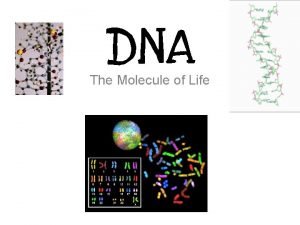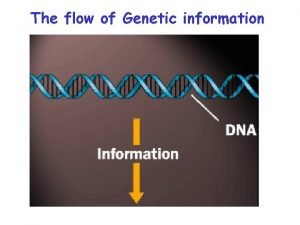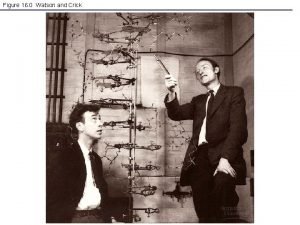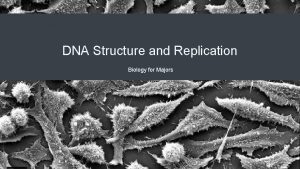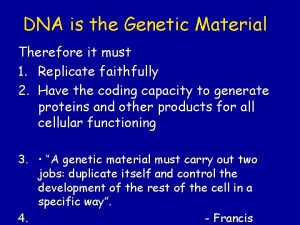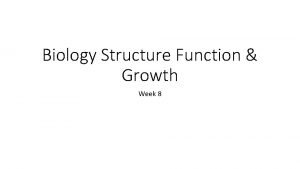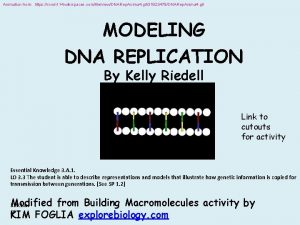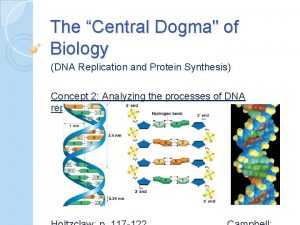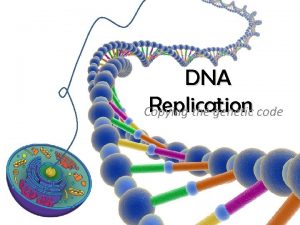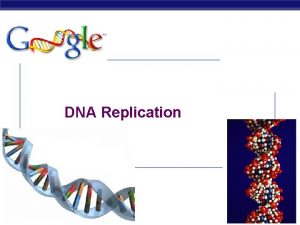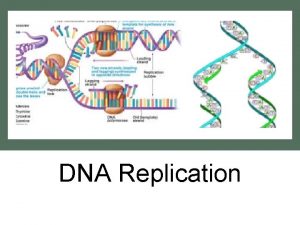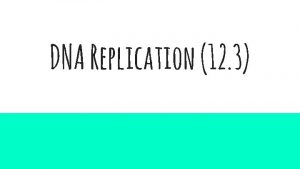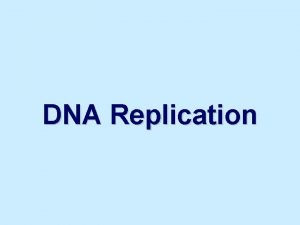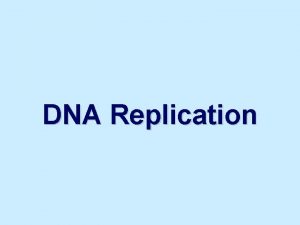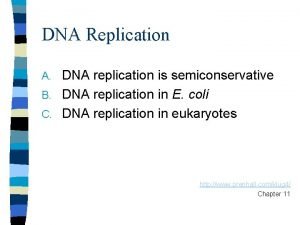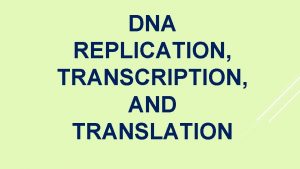DNA Replication Chapter 12 3 Copying the Code


















- Slides: 18

DNA Replication Chapter 12. 3

Copying the Code When Watson and Crick discovered the structure of DNA they immediately realized that the base pairing explained how DNA could be copied. Each strand of DNA has all the information necessary to reconstruct the other strand. Because each strand can be used to reconstruct the other strand we say that they are complimentary.

The Replication Process Before a cell divides it duplicates its DNA in a process called replication. This occurs during late interphase in the cell cycle and ensures that each cell has the same complete set of DNA molecules. During replication the DNA separates into two strands and then produces two new complimentary strands, following the rules of base pairing. Each strand of DNA acts as a template for the new strand.

The Replication Process • The DNA molecule is unzipped – this allows two replication forks to form. • As each new strand forms as new bases are added. Adenine is always joined to Thymine and Cytosine is always added to Guanine. • A=T (double bond) and C=G (triple bond). • The result is two DNA strands (made from nucleotide monomers) that are identical to each other and to the original strand. • Each DNA molecule has one of the original strands and one of the new strands.

Base Pairing

The Role of Enzymes DNA replication is carried out by a series of enzymes The enzymes are responsible for unzipping the molecule of DNA by breaking the hydrogen bonds between the base pairs and unwinding the two strands. The principle enzyme involved in DNA replication is DNA polymerase joins new nucleotides to produce a new strand of DNA polymerase also proof reads each new strand to make sure there are no errors.

The Role of Enzymes Direction of replication

Leading Strands and Lagging Strands As DNA is being replicated it has two strands a leading strand a lagging strand. As you can see the leading strand is replicated in the overall direction of DNA replication or in the 5’ – 3’ direction. However the lagging strand is replicated in the 3’ – 5’ direction which means DNA polymerase has to work in the opposite direction. This is accomplished by laying down a RNA primer and then bit by bit adding new nucleotides in fragments called Okazaki fragments. Another enzyme then cuts out the RNA primers then another enzyme fills in the gaps between the DNA fragments.

Leading Strands and Lagging Strands http: //shelf 3 d. com/kf. Ub. Yhkk 1 X 8#3 Perpetual Loop DNA replication. . . Historical animation from 1999

Other Enzymes and Proteins In addition to DNA polymerase (actually DNA polymerase III) there are several other important enzymes. • • Helicase unwinds the original DNA strand Primase adds an RNA primer in the 3’-5’ direction or lagging strand DNA polymerase I removes RNA primers DNA ligase joins the Okazaki fragments together. Single strand binding proteins also prevent the DNA from joining back together before replication can take place.

Videos http: //www. youtube. com/watch? v=yq. ESR 7 E 4 b_8 http: //www. youtube. com/watch? v=Onusp. QG 0 Jd 0

Telomeres The tips of chromosomes are known as telomeres. Because of the way in which DNA is replicated the tips of chromosomes are hard to copy. Over time DNA can actually be lost from telomeres each time a chromosome is replicated. Another enzyme called telomerase compensates for this problem by adding short repeated DNA sequences to the telomeres. This makes it less likely that important genes will be lost during replication.

Eukaryotic Cells vs Prokaryotic Cells DNA replication differs in prokaryotic cells and eukaryotic cells. The cells of prokaryotes have a single circular DNA molecule that contains most of the cells genetic information Eukaryotic cells have up to 1000 times more genetic information and this is found in the nucleus packaged into chromosomes. Together the DNA and histone proteins tightly pack together to form nucleosomes. The nucleosomes condenses to form chromatin and the chromatin condenses further into chromosomes.

Eukaryotic DNA

The Prokaryotic Cell Cycle The prokaryotic cell cycle is a regular pattern of growth, DNA replication, and cell division that can take place very quickly under ideal conditions. Little is known about the prokaryotic cell cycle but scientists believe that once the cell reaches a certain size, DNA replication begins and the cell divides. The process of cell division in prokaryotes is a form of asexual reproduction known as binary fission.

Binary Fission • The chromosome is replicated • The two DNA molecules attach to opposite ends of the cell • A network of fibers forms between them stretching from one side of the cell to the other • The fibers constrict and the cell is pinched inward, dividing the cytoplasm and the chromosomes between two newly formed cells

Binary Fission

Eukaryotic Cell Cycle
 Bioflix activity dna replication lagging strand synthesis
Bioflix activity dna replication lagging strand synthesis What are the enzymes involved in dna replication
What are the enzymes involved in dna replication Replication
Replication Chapter 11 dna and genes
Chapter 11 dna and genes Forms of dna
Forms of dna Dna stand for
Dna stand for 3-5 exonuclease vs 5-3 exonuclease
3-5 exonuclease vs 5-3 exonuclease 5 enzymes responsible for dna replication
5 enzymes responsible for dna replication Polyribosomes
Polyribosomes Dna structure and replication packet answer key
Dna structure and replication packet answer key Major enzymes in dna replication
Major enzymes in dna replication Antiparallel in dna replication
Antiparallel in dna replication Dna replication jeopardy
Dna replication jeopardy Replication fork labeled
Replication fork labeled Missy baker
Missy baker What is this
What is this Nucleoside triphosphate in dna replication
Nucleoside triphosphate in dna replication Bioflix dna replication
Bioflix dna replication Cell analogy restaurant
Cell analogy restaurant





